- V
- GF
- NS
- DF
- View Recipe Key
How to Make Roman-Style Pizza from Scratch (Inspired by Rome’s Forno Campo de Fiori Pizza)
How to Make Roman-Style Pizza from Scratch (Inspired by Rome’s Forno Campo de Fiori Pizza)
This recipe will teach how to make Roman-style pizza from scratch. Inspired by the memorable pizza sold at Rome’s Forno Campo de Fiori.
This post contains affiliate links. Full disclosure is at the bottom of the article.
I’ve recently noticed that when I think back on my recent trip to Rome, of all the amazing food I enjoyed, it’s pizza I remember best. Well, maybe it shouldn’t come as such a surprise given the city’s pizza-making notoriety, but I didn’t expect it to be the dish that would stick to my mind. During our stay in Italy’s capital, E and I had pizza at many different trattorie, but the one pizza I remember best and still long for, months after, was the one served by weight at a take-out counter. Forno Campo de Fiori was always packed: keeping my place in line without being passed by locals used to the place’s chaotic ordering and check-outing process was always a bit of a sport, but the prize was absolutely worth the struggle.
Forno’s pizza is cooked as 6-foot long pies and is served with different toppings, but the combinations are always very simple. Usually, two or three carefully chosen ingredients garnish the pizza’s crunchy dough, but the place is also famous for its minimalist pizza bianca, topped only with olive oil and coarse sea salt, which should become the poster-child for the merits of culinary simplicity.
Forno Campo de’ Fiori’s Pizza Bianca:
We loved Forno’s so much that we went back to taste many varieties but our favorite was the zucchini pizza – the soft, nutty taste of thinly sliced zucchini combined with the milkiness of fresh mozzarella, contrasting with the crust’s saltiness was an absolute chef d’oeuvre and we went crazy for it. Seriously, I could have eaten that pizza every day for a week. Of course, the fact that we enjoyed our €2 slices sitting on the rim of Campo de Fiori’s fountain under the warm fall sun, while we watched busy and elegant Romans walk by didn’t hurt to imprint the souvenir upon my memory either.
Campo de Fiori’s Zucchini Pizza:
Picture-Perfect Campo de Fiori, Rome:
Back home, I started to experiment making Roman pizza, wanting to come as close to Forno’s as I could. Much of the success depended on the crust’s crispiness, which was difficult to achieve in a regular home oven. Also, as I usually made the pizza dough in my bread machine, my efforts produced a crust which rose too much during the baking process, even when rolled paper-thin.
Then the “new” Bon Appetit came along, with its first Italy-focused issue. I bought it out of curiosity, and found a recipe for Roman pizza that felt very close to the goal I was trying to reach. I couldn’t resist trialing the recipe just a couple of days after. I kneaded the dough by hand and noticed right away that it stretched very easily and held its shape even after being rolled extremely thin. I felt hopeful and garnished the pizza with a classic tomato, mozzarella di bufala, and fresh basil combination. The result was flabbergasting in its deliciousness: I couldn’t have come closer to the goal I was trying to reach. We wolfed down the first pie and I promised to quickly make the zucchini variety – which I did a couple of days later with equal success.
I now believe I have found the perfect Roman-style pizza dough. If you like thin, crispy pizza, I believe you’ll fall in love with it too. Don’t be put off by the idea of making your own dough by hand, it’s a lot quicker than you think – believe me, I don’t have a lot of patience for dough but this one was easy. Once you have made the dough, the key to the perfect pizza is keeping the toppings simple and using the very best ingredients. Now is the time to use your best olive oil, to splurge on mozzarella di bufala and to sprinkle liberally with precious fleur de sel. Your taste buds will thank you.
Helpful Tip for Making Roman-Style Pizza Dough
Rolling the dough extra-thin and the use of a pizza stone to bake the pizza are essential to get a crispy Roman-style crust. This recipe is for the crust only; choose the topping you want to try (see recipes below) and read recipes carefully to multi-task while the pizza dough is resting.

Roman-Style Pizza Dough
Ingredients
- 2 tsp granulated sugar
- 1 ½ tsp active dry yeast
- 2 ½ tbsp extra-virgin olive oil, divided
- 1 tsp kosher salt
- 2 ¼ cups all-purpose flour, plus more for dusting
Instructions
Make the pizza dough
- Combine ¾ cup warm water (100°-115°F / 38-46°C), sugar, and yeast in a large bowl; let sit until spongy, 4-5 minutes. Mix in 1 ½ tbsp of the olive oil and the salt. Stir in 2 ¼ cups of the flour. Turn out onto a work surface; knead until smooth and elastic, adding more flour when the dough is sticking, about 6 minutes total. Grease a large bowl with 1 tablespoon olive oil. Add dough, cover bowl with plastic; let rise until doubled, about 90 minutes.
- Meanwhile, position one rack in the top third of the oven and another in the bottom third; place a pizza stone on the top rack and preheat the oven to 500°F (260°C). Preheat for 45 to 60 minutes.
- Divide the dough in half. At this point, you can wrap the dough balls individually in plastic wrap and store in the refrigerator for a couple of days, or store in a plastic storage bag in the freezer for 1 to 2 months.
Roll out the Roman pizza dough
- Sprinkle a clean, working surface and one of the balls of pizza dough with flour. Roll out the dough in a very thin, large rectangle with rounded corners (it doesn’t have to be perfect; in fact, it’s more authentic if it isn’t!). The thinner you manage to roll the crust, the crunchier it will be. I like to go as thin as 1/4-in (0.6 cm), but you can go thicker if that’s what you prefer.
- Cut out a piece of parchment paper large enough to hold the pizza dough. Fold the dough in half and transfer to the parchment paper (the paper will make it easier to transfer the pizza to the oven, as the thinness of the crust would make it virtually impossible to slide the pizza off onto the stone). Cover the dough with a clean kitchen towel and let rest for 15 minutes.
- Garnish the Roman-style pizza crust as desired. Transfer the pizza (with the parchment paper) to the pizza stone in the oven and bake for about 8 minutes, or until golden brown and bubbly.
- Recipe Credit: Adapted from Bon Appétit Magazine.
Did you make this?
Tell me how you liked it! Leave a comment or take a picture and tag it with @foodnouveau on Instagram.

Roasted Cherry Tomatoes, Basil, and Arugula Roman-Style Pizza
Ingredients
- 1 ball homemade Roman-style pizza dough (half a batch)
- ¾ lb cherry tomatoes
- Extra-virgin olive oil
- Fleur de sel, or flaky sea salt
- Freshly ground black pepper
- ¼ cup finely grated Parmigiano-Reggiano cheese
- 1 small ball Mozzarella di Bufala (about 5 oz / 140 g), sliced thinly
- 2 large handfuls arugula
- Fresh basil leaves (optional)
Instructions
To roast the cherry tomatoes
- Position a rack in the lower third of the oven. Place a pizza stone on the rack and preheat the oven to 500°F (260°C). Preheat for 45 to 60 minutes to allow the stone to absorb as much heat as possible.
- Cover a baking sheet with aluminum foil. Scatter the cherry tomatoes over. Drizzle with 1 tbsp (15 ml) olive oil, then season with salt and pepper. Set the baking sheet over the pizza stone and roast the tomatoes until their skins split and becomes blackened in spots, 10 to 12 minutes. Remove and let cool slightly. Leave the oven on.
Roll out the Roman pizza dough
- Sprinkle a clean, working surface and one of the balls of pizza dough with flour. Roll out the dough in a very thin, large rectangle with rounded corners.
- Cut out a piece of parchment paper large enough to hold the pizza crust. Fold the crust in half and transfer to the parchment paper (the paper will make it easier to transfer the pizza to the oven, as the thinness of the crust would make it virtually impossible to slide the pizza off onto the stone). Cover the crust with a clean kitchen towel and let rest for 15 minutes.
Garnish and bake the pizza
- Generously brush the pizza crust with extra-virgin olive oil. Sprinkle with the grated Parmigiano-Reggiano, then distribute the slices of buffalo mozzarella over the crust. Nestle the roasted tomatoes in between the mozzarella slices. Season with salt and pepper.
- Using a pizza peel or a large cutting board, carefully transfer the pizza (with the parchment paper) onto the preheated pizza stone in the oven. Bake until the crust is browned and crisp and the cheese is bubbly, about 10 minutes.
- SERVING: Pull the pizza out of the oven. Sprinkle with the arugula and some fresh basil leaves, if desired. Serve immediately.
Did you make this?
Tell me how you liked it! Leave a comment or take a picture and tag it with @foodnouveau on Instagram.
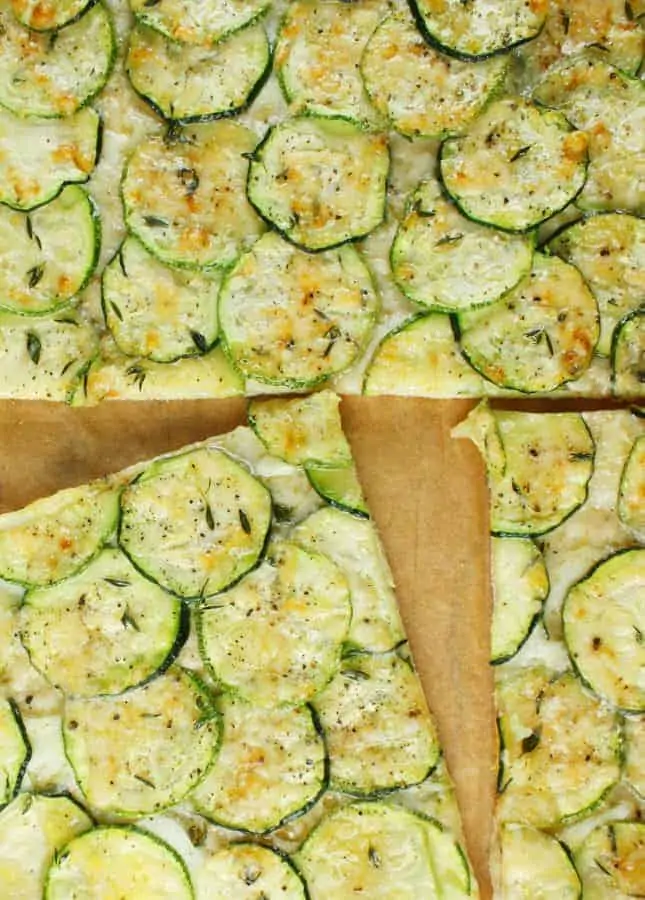
Roman-Style Zucchini Pizza
Ingredients
- 1 ball homemade Roman-style pizza dough (half a batch)
- ¼ cup extra-virgin olive oil
- 1 clove garlic
- ⅓ cup finely grated Parmigiano-Reggiano cheese
- 2 small zucchini (about 7 oz / 200 g)
- Fleur de sel, or sea salt flakes
- Freshly ground black pepper
- 1 small ball Mozzarella di Bufala (about 5 oz / 140 g), sliced thinly
- 1 tbsp fresh thyme leaves
Instructions
Prepare the ingredients and preheat the pizza stone
- Pour the olive oil in a small bowl. Very finely mince or grate the garlic clove, then mix it into the oil. Set aside to infuse. (You can prepare the garlic oil ahead of time; refrigerate until needed.)
- Slice both zucchini in extra-thin slices (a mandoline slicer is the best tool to do this).
- Position a rack in the lower third of the oven. Place a pizza stone on the rack and preheat the oven to 500°F (260°C). Preheat for 45 to 60 minutes to allow the stone to absorb as much heat as possible.
Roll out the Roman pizza dough
- Sprinkle a clean, working surface and one of the balls of pizza dough with flour. Roll out the dough in a very thin, large rectangle with rounded corners.
- Cut out a piece of parchment paper large enough to hold the pizza crust. Fold the crust in half and transfer to the parchment paper (the paper will make it easier to transfer the pizza to the oven, as the thinness of the crust would make it virtually impossible to slide the pizza off onto the stone). Cover the crust with a clean kitchen towel and let rest for 15 minutes.
Garnish and bake the zucchini pizza
- Generously brush the pizza crust with garlic-infused olive oil.
- Sprinkle with a third of the grated Parmigiano-Reggiano, then distribute the slices of buffalo mozzarella over the crust.
- Set the thin zucchini slices over the pizza in an overlapping pattern.
- Season the zucchini with a generous pinch of fleur de sel (make sure the salt is distributed evenly all over the pizza) and some black pepper. Sprinkle with the remaining Parmigiano-Reggiano and drizzle with the remaining garlic-infused olive oil.
- Using a pizza peel or a large cutting board, carefully transfer the pizza (with the parchment paper) onto the preheated pizza stone in the oven. Bake until the crust is browned and crisp and the cheese is bubbly, about 10 minutes.
- SERVING: Pull the pizza out of the oven. Sprinkle with the fresh thyme leaves and serve immediately.
Did you make this?
Tell me how you liked it! Leave a comment or take a picture and tag it with @foodnouveau on Instagram.
This site is a participant in the Amazon Associates Program, an affiliate advertising program designed to provide a means for the site to earn fees by linking to Amazon and affiliated sites.
If you click on an affiliate link, I may earn advertising or referral fees if you make a purchase through such links, at no extra cost to you. This helps me creating new content for the blog–so thank you! Learn more about advertising on this site by reading my Disclosure Policy.
Author: Marie Asselin




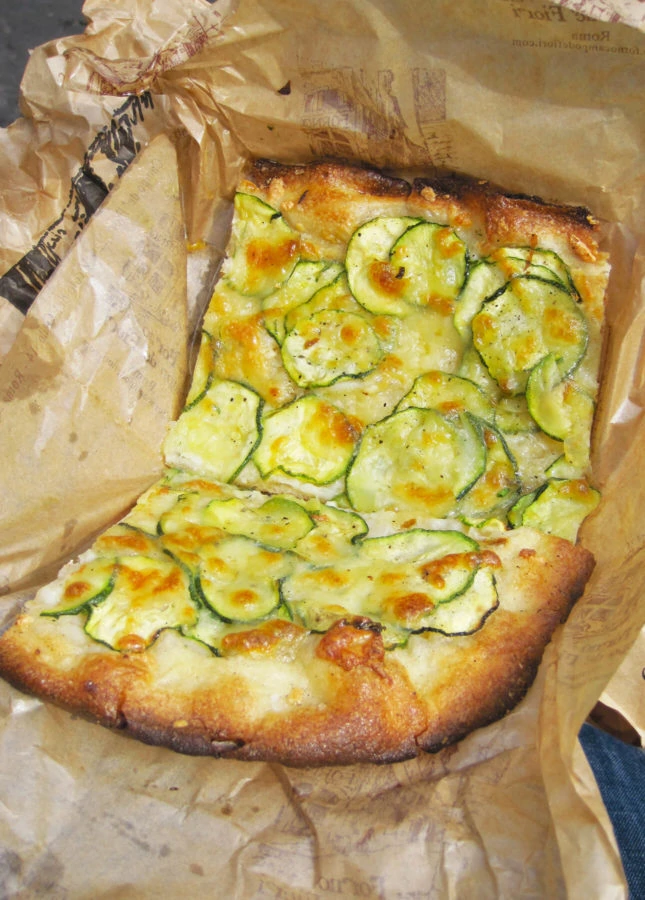
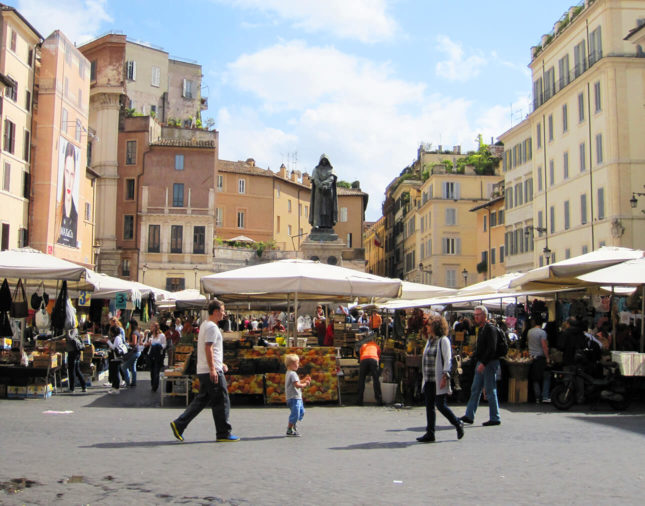
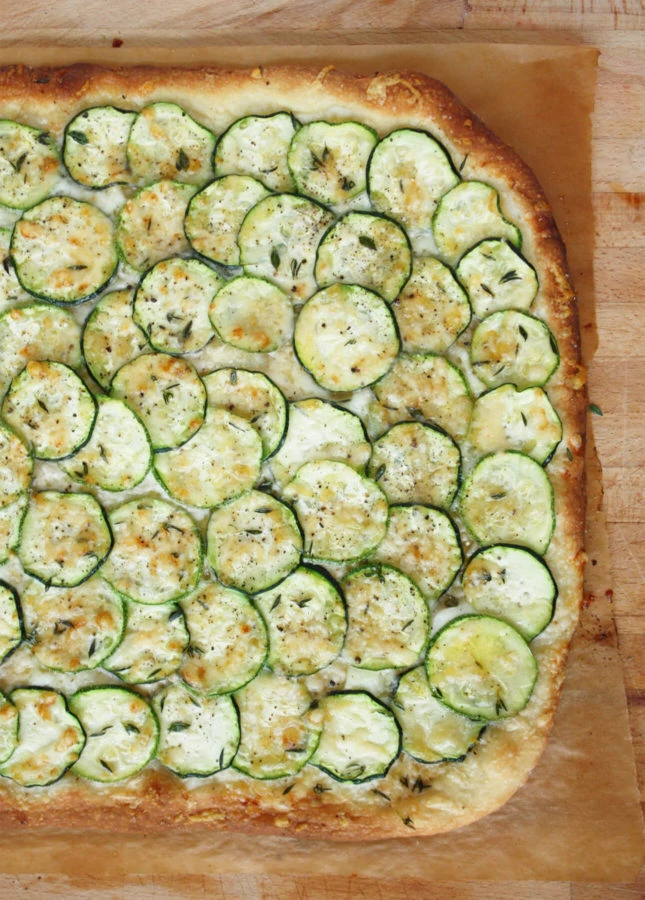
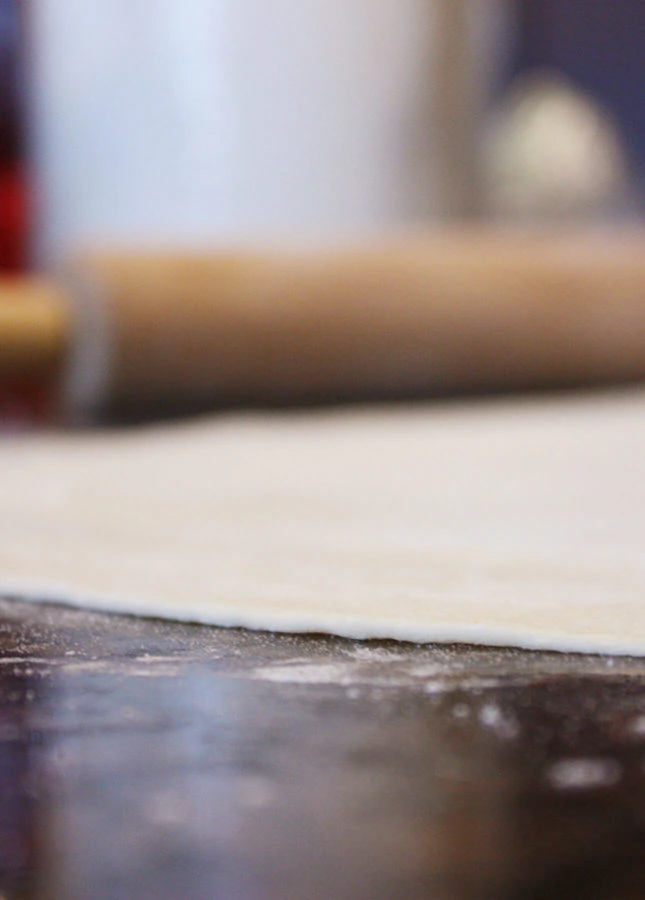


You say set the oven temperature to 500 F, and use parchment paper underneath the dough while baking. But most parchment paper burns at 450 degrees. Please explain.
Hey Johnny, I think because the parchment paper is set on the pizza stone and most of it rests under the pizza, it’s sort of “protected” from burning. I’ve been using parchment paper forever and while the edges of the parchment around the pizza do brown a bit, it doesn’t burn. It’s so handy to slide the pizza in and out of the oven!
Just found this as I was craving Roman-style pizza..I stop by Forno Campo Di Fiori every time I’m in Rome…usually multiple times! Thanks!
We spent a month in Rome this spring and enjoyed many, many pizzas. Your website saved me hours of research. We enjoyed both your pizzas and they were as good as in Rome. I use a bread machine to make a double portion of dough, divide it into four parts, and freeze them. Thawed dough is relaxed and a lot easier to roll and stretch. I have a steel, 16 inch perforated pizza form and it works well. I have not found a large enough pizza stone to suit me. I am thinking of cutting down a large floor tile to fit my stove. I have photos to share, but don’t know how to send them to you. I am looking for more toppings.
I agree, the parchment makes this whole process doable. I used commercially prepared dough and still had great results. I also used the Cuisinart processor to cut the zucchini evenly and thinly. The pizza was wonderful and I have referred to your blog. Also, my second pizza was a base of homemade pesto, mozzarella, coppociola, fresh herbs and parmesan regianno. Superb. You can even make it ahead of your guests’ arrival and reheat it for 5 minutes at 400.
Tried the zucchini pizza today.. My LORD! It`s the mother of all pizzas! Thank you <3
this blog rules
The best pizza a ever tasted . Forno in Rome
Hi, this recipe looks and sounds amazing. I can’t wait to try it. Can someone tell me how long this dough can keep in the fridge and freezer? make ahead would be ideal! Thanks :)
You can keep the dough wrapped in plastic wrap and a freezer-safe resealable bag for 24 hours in the fridge and up to a month in the freezer. Thaw overnight in the fridge or at room temperature for at least 30 minutes.
I made this dough yesterday using bread flour. I let it sit in the fridge overnight and most of the day today. Brought it to room temp. Rolled. Topped. Baked. I love this dough. I also love the parchment idea. It worked terrific. Normally I get mad because the pizza sticks to the peel and then my toppings are a mess when it finally hits the stone.
I just made this for lunch. The best thin, crispy pizza dough I’ve made so far! Very easy and I think any toppings would work well with the crispy base. I used homemade pesto and leftover roast duck. Odd combo, but tasted great with the wonderful pizza base!